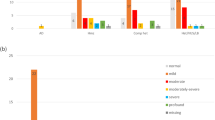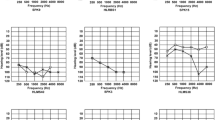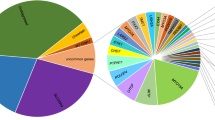Abstract
Mutations in GJB2 are the most common cause of congenital nonsyndromic hearing loss. The controversial allele variant M34T has been hypothesized to cause autosomal dominant or recessive nonsyndromic hearing impairment and some in vitro data has been consistent with this hypothesis. In this report, we present the clinical and genotypic study of 11 families (seven familial forms of nonsyndromic sensorineural hearing loss (NSSNHL) and four sporadic cases) in which the M34T GJB2 variant has been identified. The M34T mutation did not segregate with the deafness in six of the seven familial forms of NSSNH. Eight persons with normal audiogram presented a heterozygous M34T variation and five normal hearing individuals were composite heterozygous for M34T and another GJB2 mutation. Four normal hearing individuals with a documented audiogram were M34T/35delG and one was M34T/(GJB6-D13S1830)del. Screening a French control population of 116 subjects we have found an M34T allele frequency of 1.72%. This percentage was not significatively different from the prevalence of the M34T allele in the deaf population, which was 2.12%. All these data suggest that the M34T variant is not clinically significant in human and is a frequent polymorphism in France.
Similar content being viewed by others
Log in or create a free account to read this content
Gain free access to this article, as well as selected content from this journal and more on nature.com
or
References
Petit C, Levilliers J, Marlin S et al: Hereditary hearing loss. In: Scriver CR, Beaudet AL, Sly WS, Valle D. (Eds): The metabolic and molecular bases of inherited disease. Montreal: McGraw-Hill; 2001, pp 6281–6328.
Denoyelle F, Marlin S, Weil D et al: Clinical features of the prevalent form of childhood deafness, DFNB1, due to a connexin26 gene defect: implications for genetic counselling. Lancet 1999; 353: 1298–1303.
Denoyelle F, Lina-Granade G, Plauchu H et al: Connexin26 gene linked to a dominant deafness. Nature 1998; 393 (6683): 319–320.
Rabionet R, Gasparini P, Estivill X : Molecular genetics of hearing impairment due to mutations in gap junction genes encoding beta connexins. Hum Mutat 2000; 16 (3): 190–202.
Kelsell DP, Dunlop J, Stevens HP et al: Connexin 26 mutations in hereditary non-syndromic sensorineural deafness. Nature 1997; 387: 80–83.
White TW, Deans MR, Kelsell DP et al: Connexin mutations in deafness. Nature 1998; 394: 630–631.
Kelsell DP, Wilgoss AL, Richard G et al: Connexin mutations associated with palmoplantar keratoderma and profound deafness in a single family. Eur J Hum Genet 2000; 8 (6): 469–472.
Kelley PM, Harris DJ, Comer BC et al: Novel mutations in the connexin 26 gene (GJB2) that cause autosomal recessive (DFNB1) hearing loss. Am J Hum Genet 1998; 62: 792–799.
Scott DA, Kraft ML, Carmi R et al: Identification of mutations in the connexin 26 gene that cause autosomal recessive nonsyndromic hearing loss. Hum Mutat 1998; 11 (5): 387–394.
Griffith AJ, Chowdhry AA, Kurima K et al: Autosomal recessive nonsyndromic neurosensory deafness at DFNB1 not associated with the compound-heterozygous GJB2 (Connexin 26) genotype M34T/167delT. Am J Hum Genet 2000; 67: 745–749.
Houseman MJ, Ellis LA, Pagnamenta A et al: Genetic analysis of the connexin-26 M34T variant: identification of genotype M34T/M34T segregating with mild-moderate non-syndromic sensorineural hearing loss. J Med Genet 2001; 38: 20–25.
Wilcox SA, Saunders K, Osborn AH et al: High frequency hearing loss correlated with mutations in the GJB2 gene. Hum Genet 2000; 106: 399–405.
Wu B, Lindeman N, Lip V et al: Effectiveness of sequencing connexine 26 (GJB2) in cases of familial or sporadic childhood deafness referred for molecular diagnostic testing. Genet Med 2002; 4: 279–288.
Martin PE, Coleman SL, Casalotti SO et al: Properties of connexin26 gap junctional proteins derived from mutations associated with non-syndromal heriditary deafness. Hum Mol Genet 1999; 8: 2369–2376.
D'Andrea P, Veronesi V, Bicego M et al: Hearing loss: frequency and functional studies of the most common connexin26 alleles. Biochem Biophys Res Commun 2002; 296: 685–691.
Thonnissen E, Rabionet R, Arbones M et al: Hum Genet 2002; 111: 190–197.
Marlin S, Garabédian E-N, Roger G et al: Connexin26 gene mutations in congenitally deaf children: pitfalls for genetic counselling. Arch Otolaryngol Head Neck Surg 2001; 127: 927–933.
Cucci R, Prasad S, Kelley P et al: The M34T allele variant of connexin 26. Genet Test 2000; 4: 335–344.
Antoniadi T, Grønskov K, Sand A et al: Mutation analysis of the GJB2 (connexin 26) gene by DGGE in Greek patients with sensorineural deafness. Hum Mut 2000; 16: 381–382.
Del Castillo I, Villamar M, Moreno-Pelayo M et al: A deletion involving the connexine 30 gene in nonsyndromic hearing impairement. N Engl Jal of Medecine 2002; 346: 243–249.
Maestrini E, Korge BP, Ocana-Sierra J et al: A missense mutation in connexin 26, D66H, causes mutilating keratoderma with sensorineural deafness (Vohwinkel's syndrome) in three unrelated families. Hum Mol Genet 1999; 8: 1237–1243.
López-Bigas N, Olivé M, Rabionet R et al: Connexin 31 (GJB3) is expressed in the peripheral and auditory nerves and causes neuropathy and hearing impairment. Hum Mol Genet 2001; 10: 947–952.
Griffith AJ, Kelsell DP, Houseman MJ et al: Genetic analysis of the connexin-26 M34T variant. J Med Genet 2001; 38: e24.
Zoll B, Petersen L, Lange K et al: Evaluation of Cx26/GJB2 in German hearing impaired persons: mutation spectrum and detection of desiquilibrum between M34T (c.101T>C) and −493del10. Hum Mutat 2003; 21: 98.
Kenneson A, Van Naarden Braun K, Boyle C : GJB2 (connexin 26) variants and nonsyndromic sensorineural hearing loss: a HuGE review. Genet Med 2002; 4: 258–274.
Hilbert P, Van Maldergem L, Gillerot Y : Use of denaturating high performance liquid chromatography (DHPLC) for connexin 26 gene mutation screening. Am J Hum Genet 1999; 65: A301.
Rice J, Clark C, Fraser L et al: Connexin 26 mutation M34T is a common finding in non syndromal deaf children in the Grampian region. J Med Genet 1999; 36 (Suppl. 1): S97.
Abe S, Usami S-i, Shinkawa H et al: Prevalent connexin 26 gene (GJB2) mutations in Japanese. J Med Genet 2000; 37: 41–43.
Park HJ, Hahn SH, Chun YM et al: Connexin26 mutations associated with nonsyndromic hearing loss. Laryngoscope 2000; 110: 1535–1538.
Oshima A, Doi T, Mitsuoka K et al: Roles of M34, C64, and R75 in the assembly of human connexin 26: implications for key amino acid residues for channel formation and function. J Biol Chem 2002; 278: 1807–1816.
Acknowledgements
We greatly appreciate the cooperation of the families. We thank Corinne Chauve, Catherine Magnier and Sébastien Chardenoux for excellent technical assistance. This work was supported by the Fondation pour la Recherche Médicale, The Association Française contre les Myopathies, The Institut National de la Santé et de la Recherche Médicale, and The Association pour l'Etude de la Pathologie Pédiatrique.
Author information
Authors and Affiliations
Corresponding author
Rights and permissions
About this article
Cite this article
Feldmann, D., Denoyelle, F., Loundon, N. et al. Clinical evidence of the nonpathogenic nature of the M34T variant in the connexin 26 gene. Eur J Hum Genet 12, 279–284 (2004). https://doi.org/10.1038/sj.ejhg.5201147
Received:
Revised:
Accepted:
Published:
Issue date:
DOI: https://doi.org/10.1038/sj.ejhg.5201147
Keywords
This article is cited by
-
Analysis of GJB2 mutations and the clinical manifestation in a large Hungarian cohort
European Archives of Oto-Rhino-Laryngology (2018)
-
Optimization of simultaneous screening of the main mutations involved in non-syndromic deafness using the TaqMan® OpenArray™ Genotyping Platform
BMC Medical Genetics (2013)
-
Two Novel Missense Mutations in the Connexin 26 Gene in Turkish Patients with Nonsyndromic Hearing Loss
Biochemical Genetics (2010)
-
Correlation between GJB2 mutations and audiological deficits: personal experience
European Archives of Oto-Rhino-Laryngology (2009)



